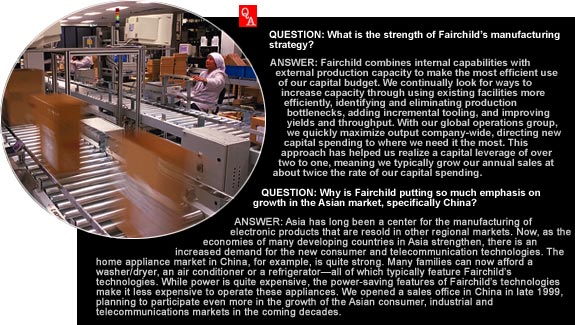 |
 |
 |
 |
You can’t win in the multi-market world without the manufacturing muscle to build and ship product at world-class service levels. Fairchild is raising our capital spending to support an aggressive double-digit growth plan focused on capturing a greater share of the wireless, interface and power management markets. In 2000, Fairchild plans to invest over $240 million in our global manufacturing facilities.
Fairchild is developing innovative new processes in our four-, five- and six-inch wafer manufacturing facilities in South Portland, Maine; Salt Lake City, Utah; and Puchon, South Korea. Our investments in our assembly and test facilities in Cebu, the Philippines and Penang, Malaysia are enabling Fairchild to respond faster and more efficiently to customer needs.
In Puchon, Fairchild developed a silicon bonding process that stacks die into a regular T0-220 package. The unique heat insulation capabilities of the bonding process means we give customers more power and functionality in the same package without the lengthy design cycle usually required for such reconfigurations.
South Portland engineers developed the FS50 BiCMOS manufacturing process to accommodate new generations of high-speed telecommunications and computer technologies—an important step in the development of smaller geometries and higher performing processes required by the burgeoning multi-market applications.
Fairchild’s multi-market business model offers distinct advantages at the manufacturing level. Other companies that serve the system-on-a-chip (SOC) market must utilize smaller and smaller manufacturing geometries—as low as 0.18 micron—which require repeated, large investments. Most of Fairchild’s products require processes no smaller than the 0.65 micron level, where capital equipment costs are much lower and the return on investment is higher. Fairchild typically realizes two dollars in annual revenue for every capital dollar invested. We’re taking these dollars and investing in our manufacturing technology, capacity and service capabilities:
- Fairchild invested more than $45 million in a single enterprise software system for all business processes, including information, order-entry and delivery systems, while planning new initiatives for e-commerce, the Internet, and supply chain integration with customer forecasts.
- We plan to invest in the Salt Lake City facility in 2000 to increase that site’s manufacturing capacity by 70 percent.
- We plan to invest in Phase I of a six-inch line expansion in the Puchon facility in 2000 with additional investments in capacity in our Penang and Cebu facilities—all to support our growing power and interface businesses.
- We plan to invest in the South Portland site to enable Fairchild to produce epitaxy, high-grade silicon used in the manufacture of semiconductors. South Portland will eventually produce enough epitaxy to meet 75 percent of its needs while sharing its supply with the Salt Lake City and Puchon manufacturing facilities.
We expect advanced cost-effective manufacturing capabilities and aggressive cost reduction and yield improvement efforts to play a significant role in improving gross operating profits. Fairchild’s long-term goal is to utilize these improvements to drive costs down at least 10 percent each year. The Penang site alone plans to nearly triple its assembly of units on highly automated lines while the South Portland facility is expected to almost double its production of six-inch wafers.
Cost-effective manufacturing is a key component in Fairchild’s drive to remain competitive at the global level.
|
 |
 |
 |
 |



